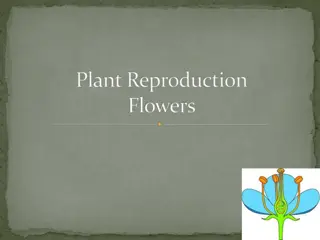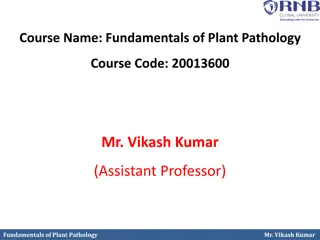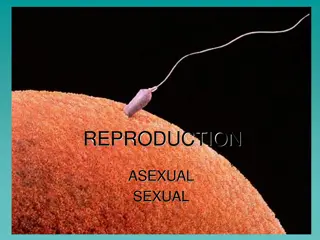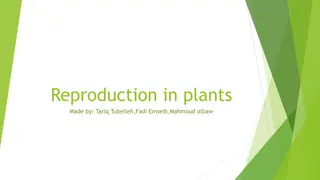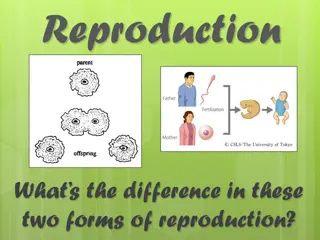Plant Reproduction and Life Cycles in Biology II for Non-Majors
Explore the complex processes of plant reproduction, life cycles, and the alternation of generations in biology. From the fusion of male and female gametes to the development of sporophytes and gametophytes, delve into the stages and structures involved in the reproduction of gymnosperms and angiosperms. Learn about the formation of pollen, male and female gametophytes, embryo sacs, flower parts, and more as you uncover the fascinating world of plant life cycles.
Download Presentation

Please find below an Image/Link to download the presentation.
The content on the website is provided AS IS for your information and personal use only. It may not be sold, licensed, or shared on other websites without obtaining consent from the author.If you encounter any issues during the download, it is possible that the publisher has removed the file from their server.
You are allowed to download the files provided on this website for personal or commercial use, subject to the condition that they are used lawfully. All files are the property of their respective owners.
The content on the website is provided AS IS for your information and personal use only. It may not be sold, licensed, or shared on other websites without obtaining consent from the author.
E N D
Presentation Transcript
Biology II for Non-Majors Plant Reproduction
Stages of a Plants Life Cycle Fusion of the male and females gametes forms the diploid zygote, which develops into the sporophyte. Plants have two distinct stages in their lifecycle: the gametophyte stage and the sporophyte stage. The haploid gametophyte produces the male and female gametes by mitosis in distinct multicellular structures.
Angiosperm Life Cycle The lifecycle of angiosperms follows the alternation of generations explained previously. The haploid gametophyte alternates with the diploid sporophyte during the sexual reproduction process of angiosperms. The male gametophyte develops and reaches maturity in an immature anther. While the details may vary between species, the overall development of the female gametophyte has two distinct phases.
Microsporangium Within the microsporangium, the microspore mother cell divides by meiosis to give rise to four microspores, each of which will ultimately form a pollen grain
Female Gametophyte: The Embryo Sac The female gametophyte is formed from mitotic divisions of the megaspore, forming an eight- nuclei ovule sac. This is covered by a layer known as the integument. The integument contains an opening called the micropyle, through which the pollen tube enters the embryo sac.
Flower Parts A typical flower has four main parts or whorls known as the calyx, corolla, androecium, and gynoecium. The outermost whorl of the flower has green, leafy structures known as sepals. The sepals, collectively called the calyx, help to protect the unopened bud. The second whorl is comprised of petals usually, brightly colored collectively called the corolla. The third whorl contains the male reproductive structures and is known as the androecium. The androecium has stamens with anthers that contain the microsporangia. The innermost group of structures in the flower is the gynoecium, or the female reproductive component(s). The carpel is the individual unit of the gynoecium and has a stigma, style, and ovary.
Complete Flower Structure
Incomplete Flowers There are two types of incomplete flowers: staminate flowers contain only an androecium, and carpellate flowers have only a gynoecium. Corn is monoecious, both flowers are on the same plant.
Practice Question What is the difference between a complete and an incomplete flower?
Comparing Angiosperms and Gymnosperms Gymnosperms The female gametophyte is present on exposed bracts of the female cone No double fertilization The male and female gametophyte structures are present on separate male and female cones Pollination by wind Angiosperms The female gametophyte exists in an enclosed structure the ovule which is within the ovary Double fertilization Male and female structures are part of the flower. Animal pollination is more common
Asexual Reproduction Advantages New plant will reach maturity faster. Less investment than making a flower and attracting pollinators. In stable conditions, genetically identical plants will do as well as parent plant. Disadvantages There isn t an increase in genetic diversity.
Natural Asexual Reproduction Many plants continue to grow from buds that are present on the surface of the stem. In some plants, such as the sweet potato, adventitious roots or runners can give rise to new plants. Some plant s leaves have small buds on their margins that grow into independent plants if they touch the soil. Some plants can be propagated through cuttings alone.
Artificial Asexual Reproduction: Grafting Grafting produces plants combining favorable stem characteristics with favorable root characteristics.
Layering In layering, a part of the stem is buried so that it forms a new plant.
Micropropagation Micropropagation is a method of producing a large number of plants from a single plant in a short time under sterile laboratory conditions.
Length of Plant Life Cycles Plant species that complete their lifecycle in one season are known as annuals. Biennials complete their lifecycle in two seasons. In a biennial s first season, the plant has a vegetative phase, whereas in the next season, it completes its reproductive phase. Perennials complete their lifecycle in two years or more. Monocarpic plants flower only once in their lifetime. Polycarpic plants form flowers many times during their lifetime.
Aging and Death in Plants Susceptibility to disease, changing environmental conditions, drought, cold, and competition for nutrients are some of the factors that determine the survival of a plant. Plants continue to grow, despite the presence of dead tissue such as cork. Individual parts of plants, such as flowers and leaves, have different rates of survival. In many trees, the older leaves turn yellow and eventually fall from the tree. Leaf fall is triggered by factors such as a decrease in photosynthetic efficiency, due to shading by upper leaves, or oxidative damage incurred as a result of photosynthetic reactions. The material is salvaged by the plant to support the growth of other plant tissues.
Quick Review Discuss the reproductive development and structure of plants. Describe asexual reproduction methods, both natural and artificial. Summarize the different plant life cycles.





